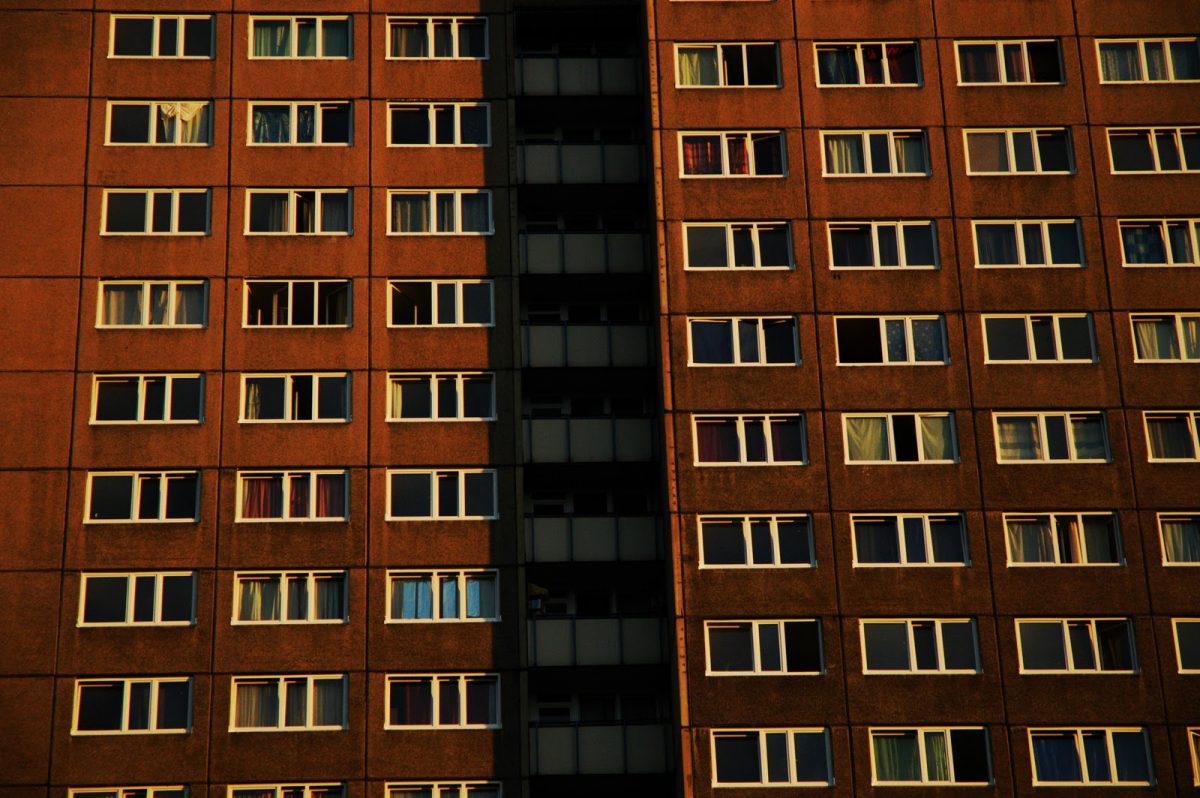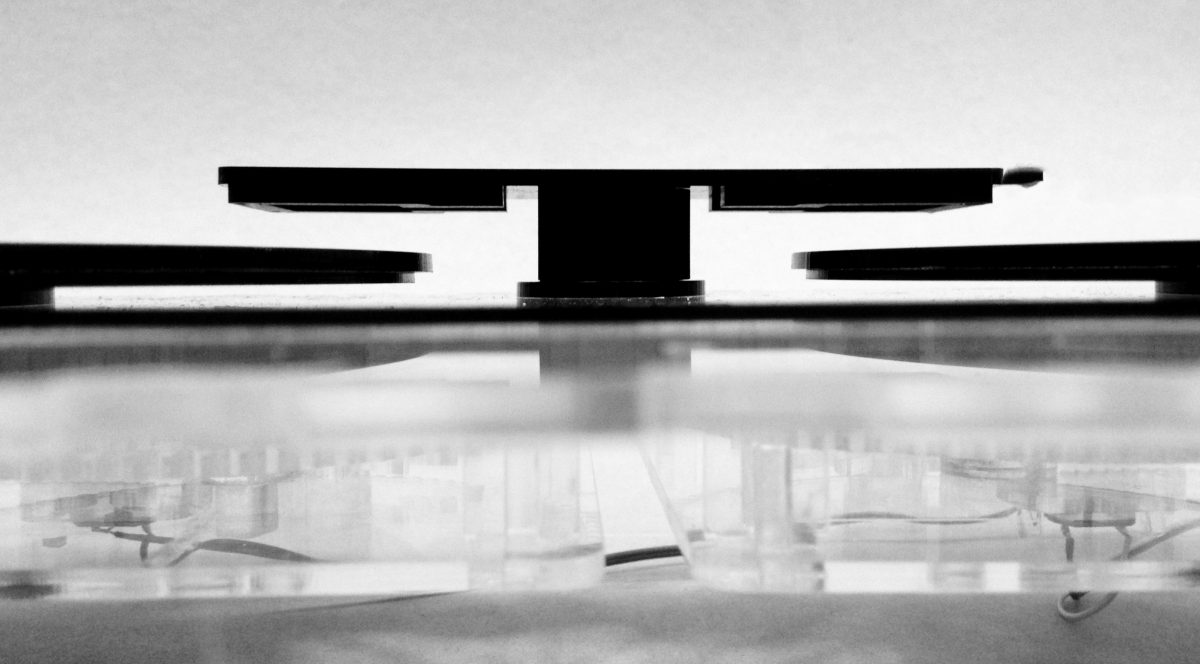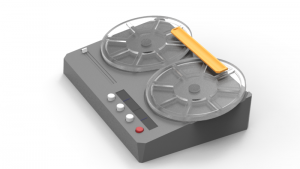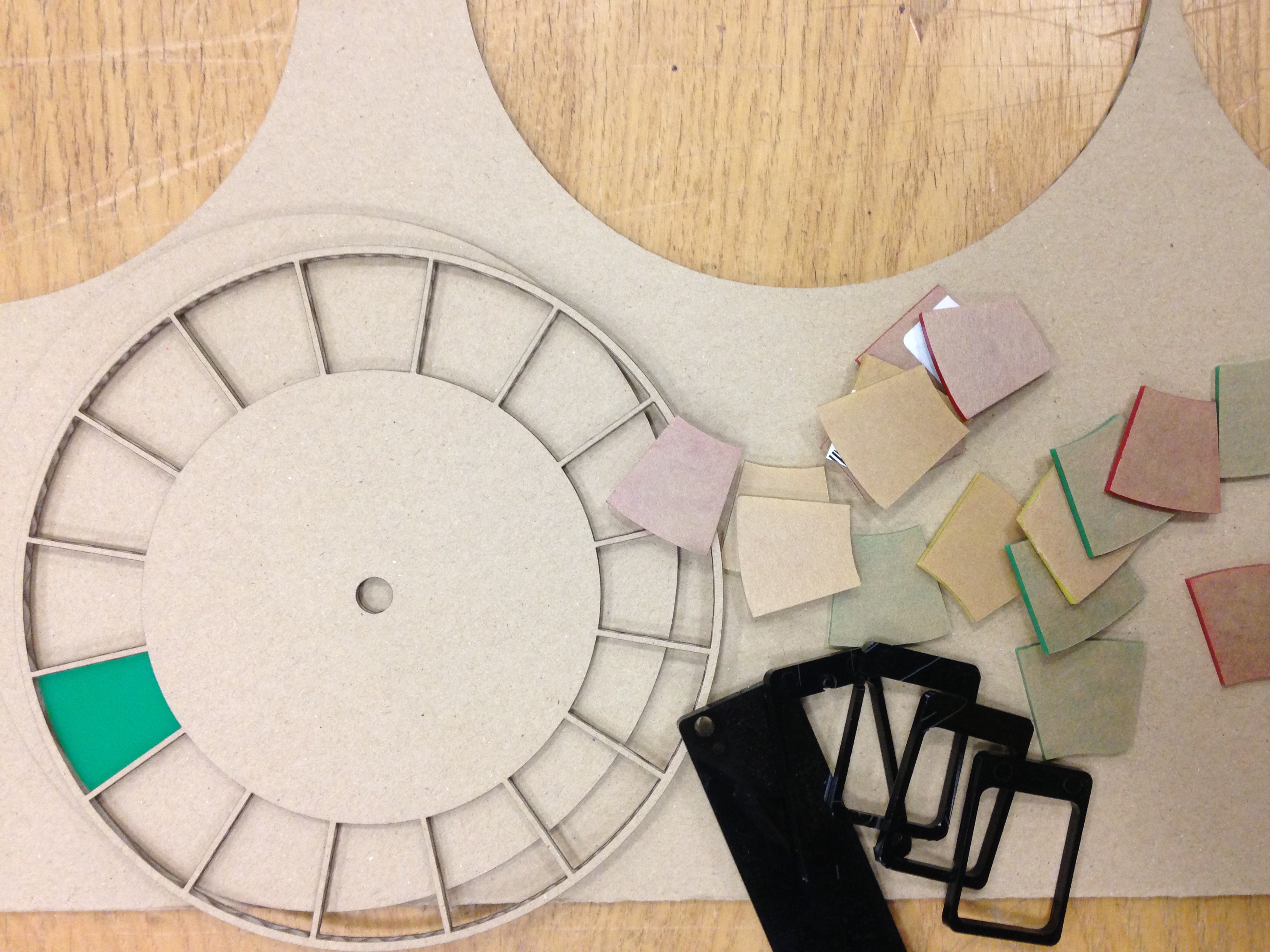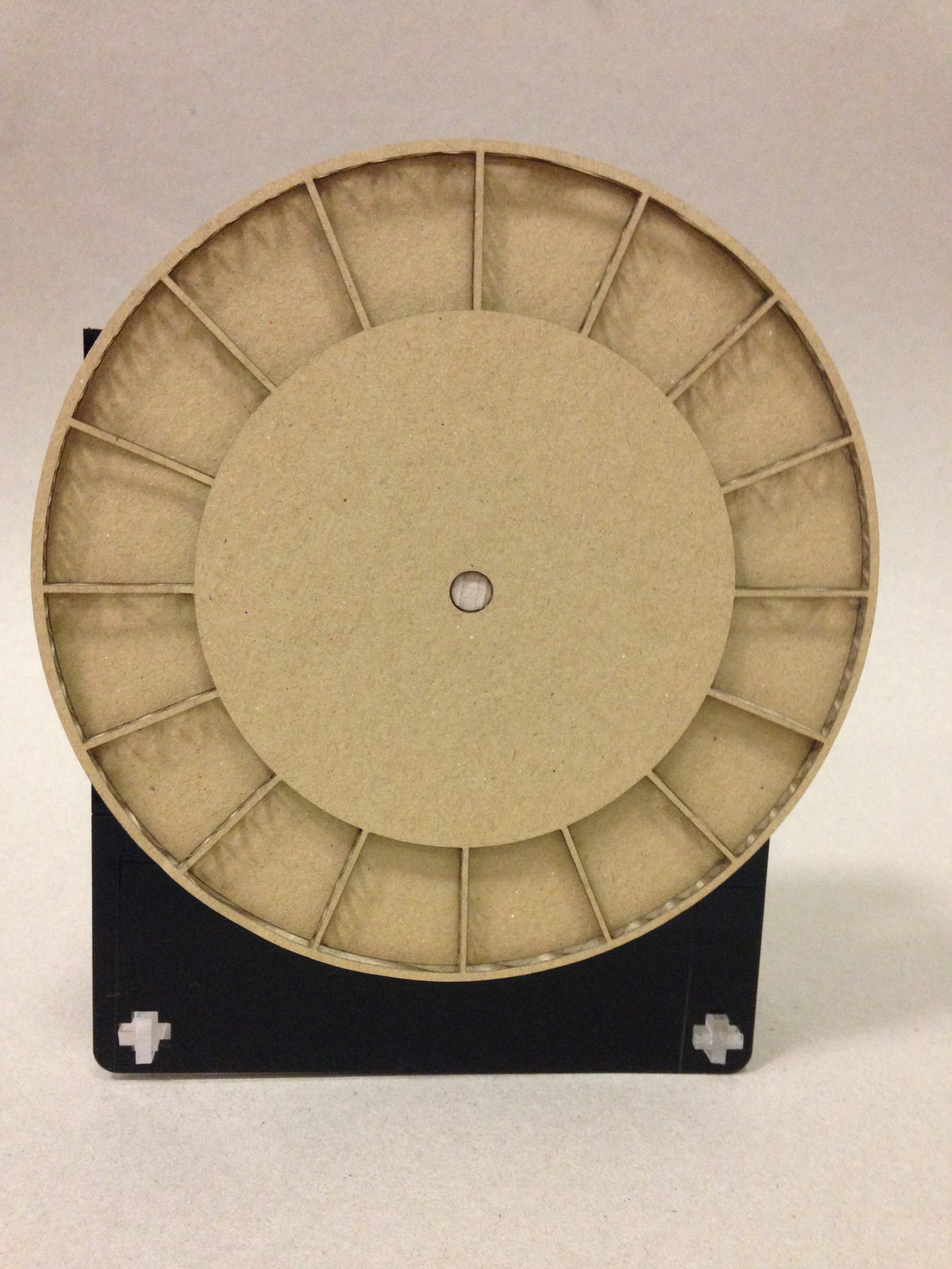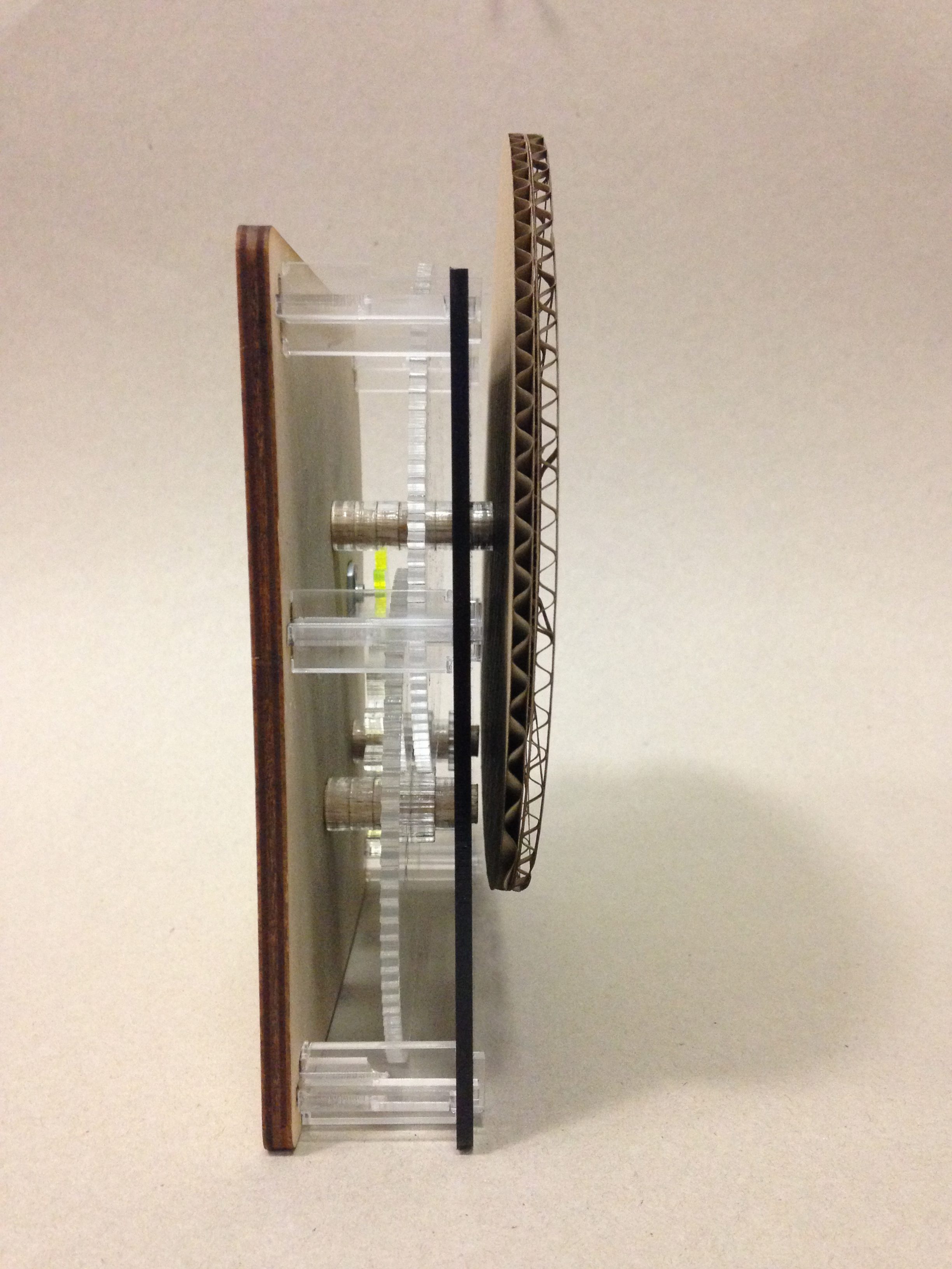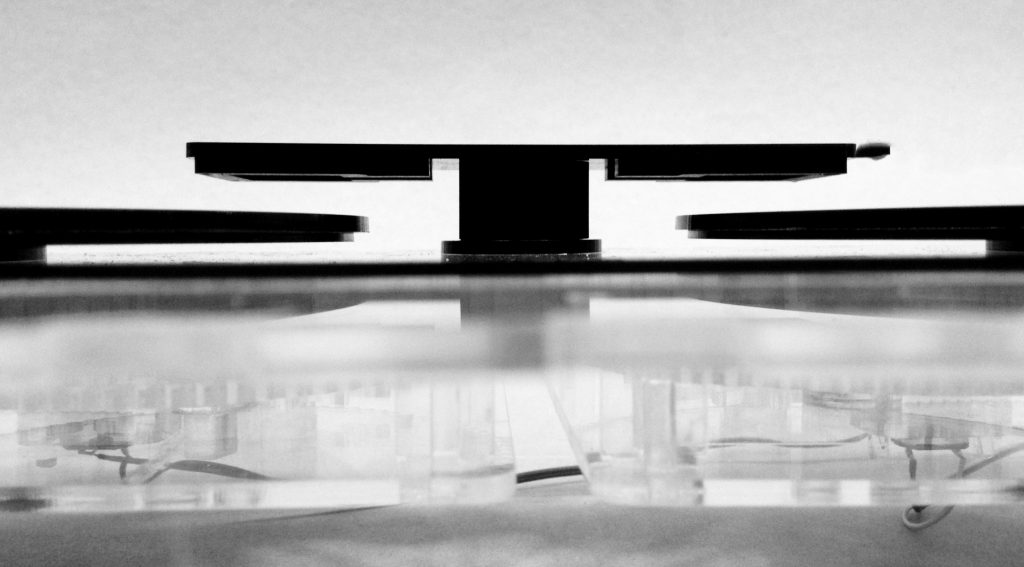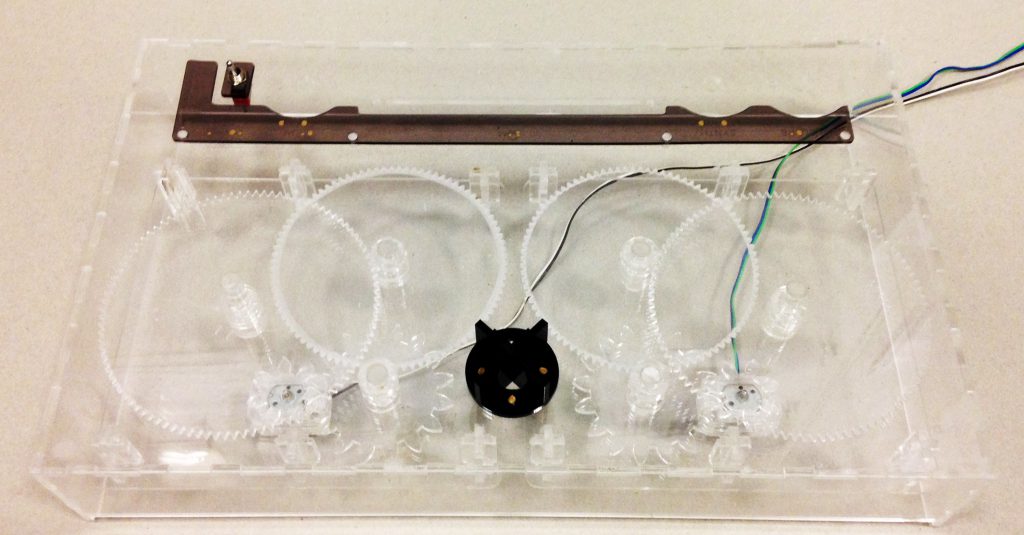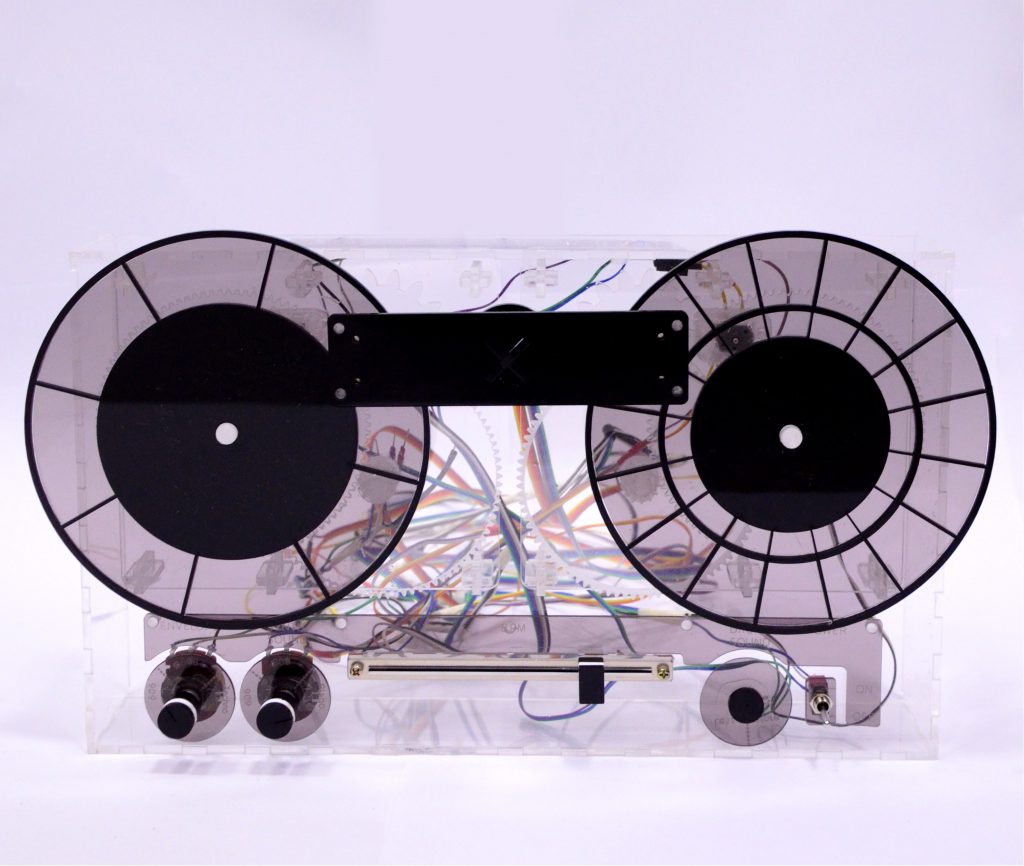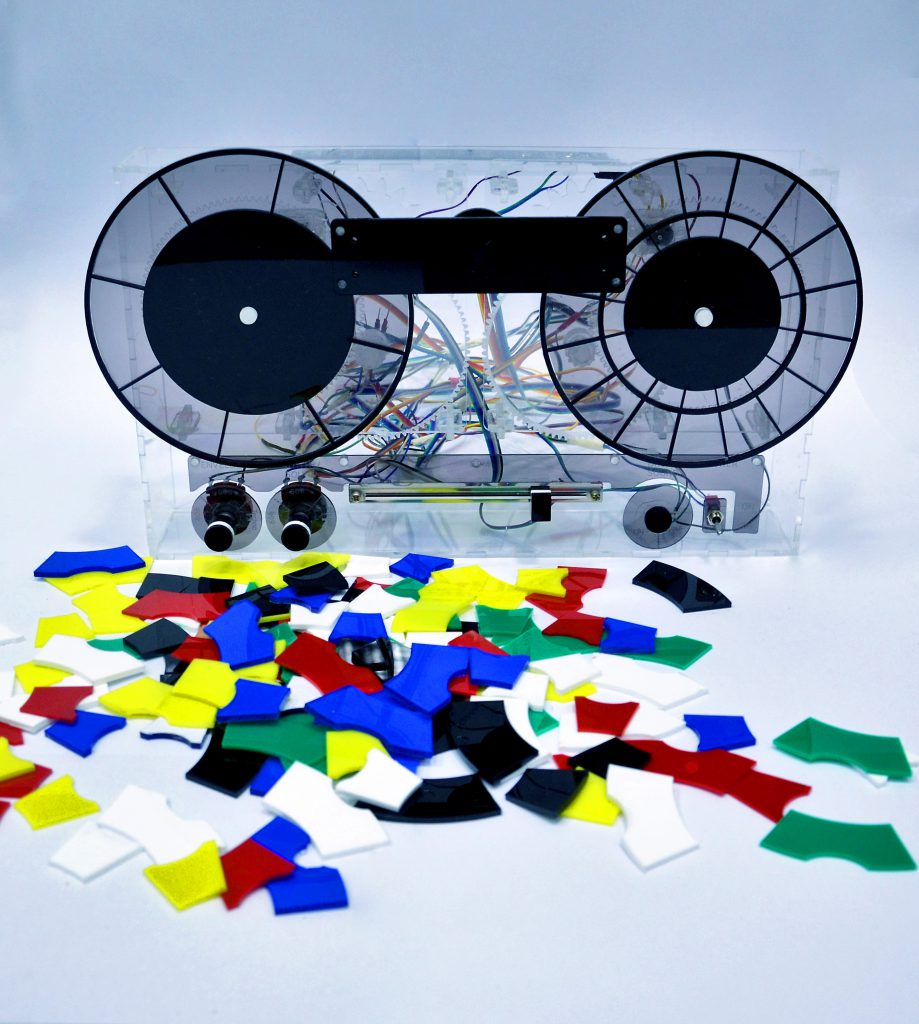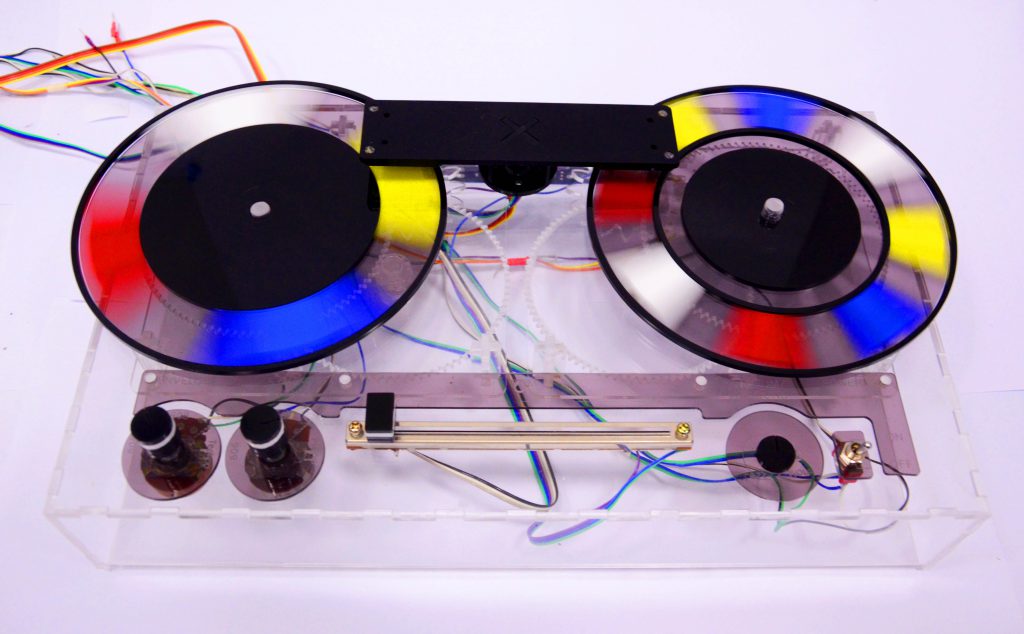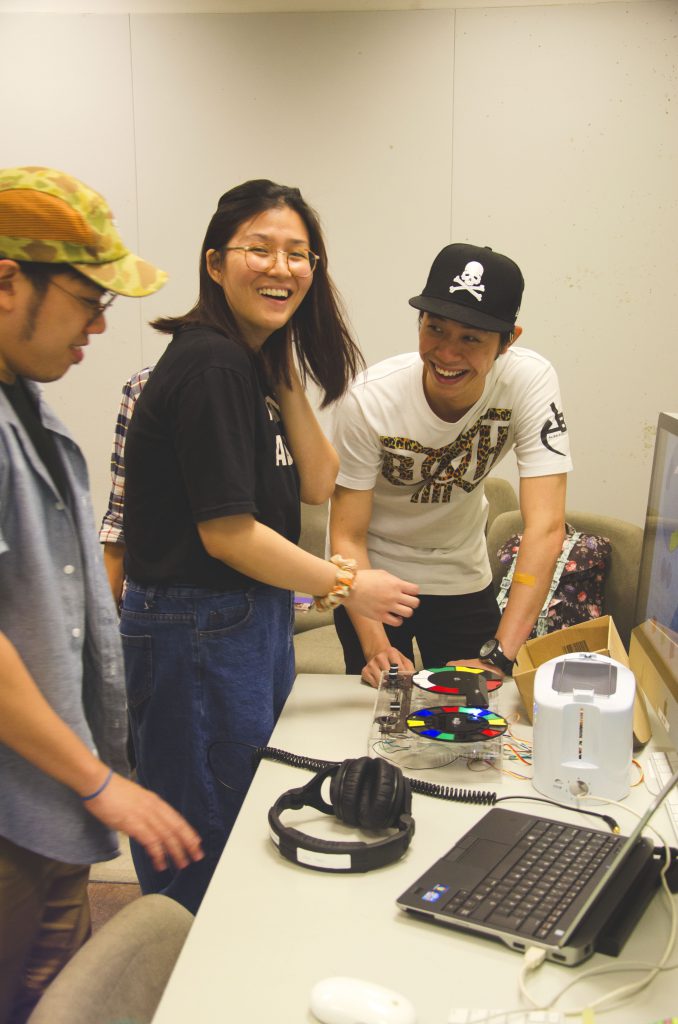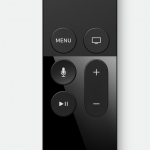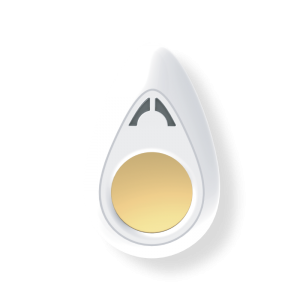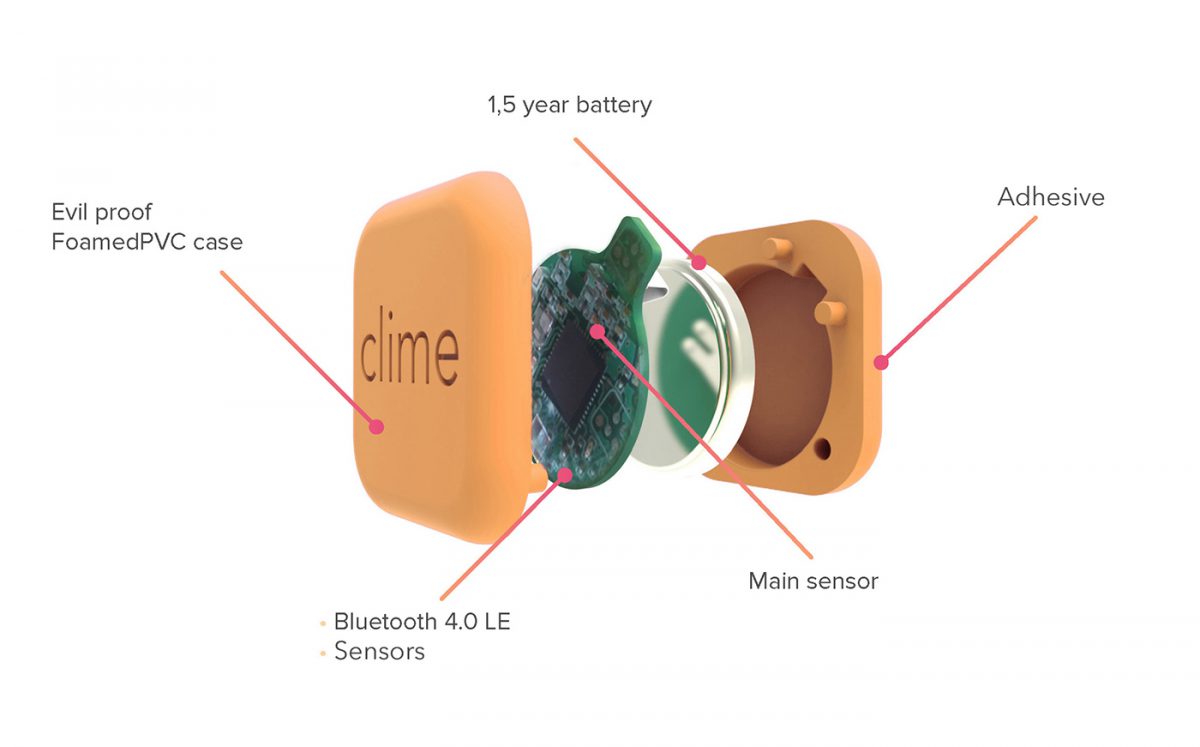Semester project process
The beginning
I knew from the beginning that I wanted to do something with sound. But I didn’t have the idea of what I wanted to do straight away so I began brainstorming about what I could do that was interesting and maybe fun for a potential user or observer. I thought of a instrument that would visualize the spectrum of a sound physically that the user would create on a potential machine.
I began to think about how this could be achieved, all the solutions I came up with was either quite clumsy, bulky or un-precise. So I dropped the idea with visualizing the spectra and moved on for a week of thinking about doing a box where you could interact with another human through a similar box in another place in the world. After a week, I dropped that idea and went back to music with a mix of colors. I started thinking about what I could do, looking for inspiration and so on. I stumbled upon the Adafruit’s RGB-sensors and I thought why not combine colors, shapes and sounds, certain colors could trigger certain sounds. How is this going to work then? Will the user just put colors under the sensors to play the song. I thought of relating the shape of the thing to old styled tape recorders to give a hint of what it could do and relate it to music.
I sketched some simple drawings and made a cad model of how I wanted it to look like, this was a bit overkill. But the look and the style could some way be derived from it:
The middle part
I started to work with the most important part, that was to get a disc to spin. First I had to deal with the speed of the engine that I was using, it was way too fast to be used to spin the disc, assumably to weak as well. So I had to create a gearbox that made the disc slower and at the same time stronger so it could manage to rotate. I made a quick test and found some scrap pieces of acrylic and cut five gears and made a disc from some cardboard. This was the first test with the gearbox, it was successful it worked and the engine managed to keep the wheels rotating.
As I got the ugly mockup to work I decided go further with my idea and by material to make the housing box, the discs, two gearboxes and the sensor holder that would hold the sensors on a fixed distance over the rotating colors on the discs.
When I started to tests with having two rgb sensors reading values at the same time I ran in to problems with the way they sent their data to the arduino. The data was not split up, so instead all data came as a merged stream of numbers. There were no solution in sight for a while and I thought of having two separate arduinos doing the reading, until I again stumbled upon a library that someone with the same problem had made where this problem was solved. This was alright when it comes to the complexity to implement it, pretty straight forward and the coding for the knobs where you change the sounds of the colors were less problematic.
The end
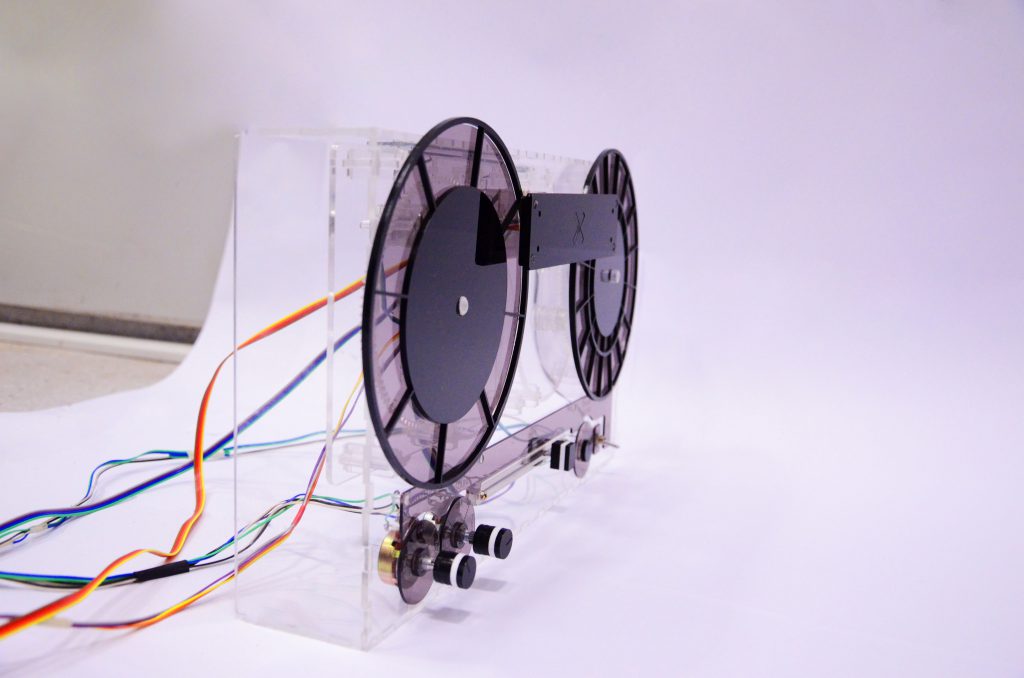
Aesthetics / message
Enough with the technical details.
I wanted to play with the synesthesia of sound, color and the sentimental part of old music machines. I wanted the user to really see the colors and connect a certain color to a sound or other way around and through this make the feeling of control of what’s coming out as a sound bigger. I wanted to convey this in a nice packaging which invited the user to play around and experiment with the colors, the sounds and the whole machine. Both colors and sound effects us all in various ways, even if you are blind or deaf sounds can make you feel the vibrations and color can be imagined. With this in mind I wanted to make something that can be appreciated by many and played with by whom who want to.
It can be as simple as a musical instrument as well, where the button or strings has been replaced with colored pieces for the user to place where they want to.
Feedback from the show
A lot of the users didn’t realise that all the functions really was working and that the different pieces of colors could be placed as they wanted. So I had to show for some people that they could experiment to a quite big extent with the machine. From time to time it was quite a lot of people playing with it, which I found really fun. First I didn’t attach the discs to the motors which meant that the users could choose how fast or slow and what direction it would spin, this was actually much appreciated. Something to keep in mind if I’m doing a second version.
Video
Pieces in the thing:
- Acrylic sheets to cut housing, discs, sensor holder, colored pieces
- Two Adafruit RGB color sensors
- Arduino
- Three potentiometers, for choosing drum/synth sound and envelope on synth
- One slide potentiometer to control the speed of the discs.
- Two dc motors
- Lots of wires
- Breadboard.
Device of the week
Musi is a interactive sequencer that allows the musician to interact with the shape through placing the cubes on different length from the musi. Its also modular and can be expanded with more than one shape at the time.
Future world 1
Future World
I think the exhibition was interesting, effect full and engaging, at the same time I noticed that it’s hard to make a really convincing interaction between the human and the interface with the computing power of today. Many of the different parts of the exhibition is cutting edge when it comes to interaction with the visitor, but sometimes it’s hard to not think about the technology behind it. With this I mean shadows from projectors, time between input and output and the resolution of images, for example. Sure this is pretty small stuff compared to the whole picture and sensation of the exhibition, but it still draws a bit of the attention from the art.
I think that the exhibition has a theme that can be felt as the visitor goes through it. As we entered the first room which was very intense and beautiful, the feeling of life and the vulnerability of it was shown with the dying flowers and the shadows of people whom had been there before us. In some way it’s a reminder of the walk of life.
The second piece was most powerful to me in my opinion. The colors and the surrounding of the artwork as the water level rises over the cliffs of the world as we lie there very comfortable. Also very describing of the day and age we live in, in the rich part of the world.
The next part of the exhibition was playful and I think that we for sure will see some of the interactive games in our homes in the future. The games seen here might change our usage of personal screens and instead make the screen to a playful interactive shared space where we interact together.
I think that the interactive designs that we’ve been trying out is good to bring about emotions which could be hard to extract through traditional art, reading and so on. When multiple senses are affected at the same time the resulting sensation is much more powerful. For example the last piece of art, when you find yourself in the middle of the LED-space with sound and lights working in a symbiosis, this is enormously effective when we want to deliver a message. Imagine what different it would be if there was a flat screen who would show the moving stars, not as powerful as when you can see them passing by in 3D. The effectiveness of the interactive medium as a way of delivering a motion of being a part of something has been used in different ways. For example, UN used augmented reality to show the everyday life of Zidra, a girl in Zaatari Refugee Camp in Jordan. By watching the interactive movie with a pair of VR-goggles you feel closer to the environment and maybe the people in the film when it’s possible to look around during the time goes by.
As I concluded earlier is the interactive medium much more effective when it comes to make the user more engaged, as its always been, when we feel like we can effect the sequence of events we get more engaged with the problem and the solution.
Shout out to the Japanese guide who was lovely and explained one of the meanings behind the exhibition as being made to see that we’re all a part of the ecosystem and the cycle of life. Showing this through animals in the floor, flowers dying, flowers blooming, sea swallowing the earth and so on. Hopefully the message will get through and some will reflect about this.
All in all, a great exhibition and I will for sure take my mother there.
Good Designs
1 I think that Mercedes do have a good seat adjustment system that is intuitive and easy to use for the driver and passenger. From the first time using it it’s easy to know what does what in the car. See the picture, as the different parts of the seat is being moved the seat moves as well.
2 I think Airbnb has a good user interface that uses constraints and affordances in a good and usable way. This way the ways to be confused as a user is cut down to only a few, without the feel of loosing usability and lack of functions. The view-port is mainly filled with the most important in a order that goes from where you want to go, to when and then you chose where you want to stay.
3 Apple Tv remote is a good example on taking the characteristics from the other products of the brand and applying it to other product groups. The new apple tv remote is very usable and uses the touch almost in the same way as apple uses it in other products, as a previous apple user will recognize and adapt to fast. Though it might take longer for people used to other brands to adapt.
Device of the weak
The device of the week is a thing that can measure your stress level through measuring the conductivity of your skin. The data is then transferred in to an app…
Link->PIP
Reading WK#6
I think the reading gave some good insights on the topic of design, even though it was a broad explanation with the main topic of interaction design mixed up with parts of product design as well, and the common design patterns the two design areas share. I thought of it as the authors wanted to give the reader a insight of what kind tools of traditional design that can be transferred to the problems we meet today with a more digitized area of design. What do we need to consider when our designs are non-physical and exists on digital platforms, where the user won’t interact with a traditional object? The question of democratic design is also touched up on, which I think is interesting. How many of the apps today take in consider people with impaired vision or less effective coordination of movement? Yes, sure, you can change the font size on the phone it self, you can invert the colors on some phones and there is phones designed for people with special needs. But I haven’t seen or found any app that you can customize to your own preferences, for example the size of icons. It might also be hard to keep the original idea of the design if elements has to be sized up and change order to give the user a good experience, even though that this should be the goal.
I think that this is an really interesting question and challenge for interaction design, where the physical apparatus should contain a user friendly interface which should be able to deliver information to anyone in a society who wants to take part of it, and this is in the core really a democratic issue when more and more of the free information is moved to cyber space.
Reading wk#5 Chipchase
This weeks reading was interesting and in many ways a description of the day and age we exist in today. We carry our phones, keys and wallets day in and day out. In a way we live through our phone these days, a lot of what we experience and see is through our phones while transporting ourselves from one place to another, for example on the MRT, a majority of the commuters spend their time on the train with their phone. It might be possible to argue that we have a space that we’ve constructed within our phone that we can bring with us wherever we go, a space we decorated with the apps of our choice and a space that we know and will stay the same wherever we are. I think of this because we can bring a lot of personal stuff that we identify our self with such as music, photos, hobbies and books which would be much harder before when these things had to be worn in physical shapes, like it was before we had the possibility to carry this through the smartphone.
I wonder how this has changed us as humans, in some way it might be easy to see. I thinking of how it has effected our ability to plan and handle unforeseen happenings, while traveling etc. For a while ago a lot of planning and studying had to be made before arriving to a new destination, such as where to go when we get of the bus, where the accommodation is located and so on. Now days we don’t have to study these things upon arrival, this can be studied while traveling to the desired place through our applications on the phone where we can see our location in real time. When I think about traveling how I traveled before the smartphone entered my life I had to do a lot more research on where I was going, how I would take me there and what kind of possible effects, for example, a delay would cause on the trip. Now days we can adapt from one situation to another really quick with the help from our smartphone, but what happens if we don’t have that one life line we so much rely on?
Have our ability to adapt from one situation to another become better or worse with the availability of extreme amount of information?
Do we know more and are able to pick up all this information or do we just feel certain that we can gain any knowledge anytime depending on the situation we are in?
These are just some of the thoughts that come to me while I was reading and writing. Hope it makes sense in some way.
Device of Week#2
Clime is a small thing with multiple sensors inside it self, the sensors can feel temperature, movement, humidity and light. This gives the thing multiple areas of use for example exotic animals and herbs!
Assign. 3 – Alternative Mapping of Cities
Maps are often used by people to contextualise their surroundings when they might want to get from one place to another, understand topology or maybe study geography. Maps are interpreted different by the person using it, some imagine them self in the map as a 3D-model, some try to imagine what it will look like when they arrive other people might just try to memorise the name of the street.
I think people already use different emotions to map their surroundings. Feelings are triggered by the environment we’re moving through can still give us a clue about where we are going.
I was once in Rio de Janeiro and on beforehand I had studied the map of the area where I was about to stay. I knew that I had to get of the bus at a certain place where I could see the sea and then walk the rest of the way with the sea in my back to the place where I was about to stay. The area where I was about to stay was an okey are which means that you should know where you are going to not end up in trouble, the trouble is hard to spot on the map, but you can as a human feel the surroundings thorugh the impact on your perception of the environment. In this case when street-lightning start to disappear and streets become more narrow you can feel that you might not have the control of the situation that you want. Even though you might not be in any danger at all, its just your prejudices which’s telling you this, it can give you a clue that you might have walked to far off and it’s time to turn around.
I think maps can be made with other main orientation tools such as roads, crossings and streets. As mentioned just above, you can map the feeling of an area, how the certain place sounds like, what smells is there, the people, sidewalk activities and so on. One thing to keep in mind here is that people use different senses. Some rely more on smell when others rely on hearing and others merge these senses in to get a feeling. Some people just use their eyes and build a map inside of their head with reoccurring signs like restaurants and cafés to know that they’ve been there before and next time they probably should be going right instead of left.
Talk. One way to find a way through the city is to ask the people living there, an art that might has been forgotten when smartphones and maps always knows the fastest way through the city.
Smell. Another way could be to map the smells of the city. For example, in chinatown and little india you can feel the smell of cigarettes much more often and the smell of a certain dish could make you go right or left.
Sound. Sounds is a convenient way to guide you through the city, sounds that are significant and reoccurring can work well when it comes to find the way. I’ve used it by my self a lot of times when I tried to find a concert or maybe home from the forest
Crowds. In big cities like Singapore where you don’t necessarily have to fight for your survival crowds can be a good to orientate in the city, during the morning hours commuters move towards the MRT system, and by following the majority of the people they will probably get you there, if it’s what you desires. Crowds can be used to know that you are in a popular area and close to a good area with nice bars and restaurants.
Conclusion. Of course you could follow more old school tricks like stars, birds, cloud formations and the sun. But in these days with the haze, climate change, light pollution and so on these old tools for navigation is hard, so it might be easier to follow the crowd, listen for the particular sound clue, smell or a person to ask. In the future, where we to 45% operates in this course, we will absolutely have other ways to navigate than maps. Maybe through vibrations, sounds and maybe even by emotions triggered by our futuristic phones.
Assign. 3. Maps
I think that the subject ‘sidewalks’ is really interesting, especially because it’s from there you encounter the city and most probably where you get impressions and create memories. The meaning of sharing the sidewalk both in a direct way between us people and sharing it when it comes to a wider context such as in economic growth and progress, and to whom the sidewalk belongs to after the change has taken place is interesting. Who should we develop the sidewalk for, how should we design it? Is it for the most efficient transport of people, workers, with wide esplanades? Or is it for the sellers standing there to make their business go round? Both these interest could might go along side by side, but I can see that these two interest are competing with each other, that cities and communities whom striving towards economic growth and a more westernized lifestyle turn away from this and letting their streets belong to famous coffee companies and fast food restaurants. In a way this might be the natural way of development, which later will turn in to the search for what the particular society came from. Such as we can see now in Sweden for example where small cafés, food-trucks, street sellers, alternative restaurants reclaims more of the cityscape, streets and sidewalks in some kind of search for the genuine experience of the future of the past.
I think you, as a designer, has to consider the identity of a street, the people walking there everyday, the people working there and the people just passing by. As it was mentioned in the text, the research of a designer has to be connected to the reality through the citizen who are the user. I like the idea of the SEED network because it doesn’t matter how many prizes it has won when the human who lives, works or passing by there can’t use it.
This is just thoughts I got while reading the text, it’s easy to be caught up by small things when you write about possibilities and problems like this and you end up might missing the bigger context. Anyway, I really enjoyed the text.
How will the increasing effectiveness of our production change the cityscape and sidewalks, when automated robots and computers will do more of our work and everyday commuters might not have to go to geographically bound work?

